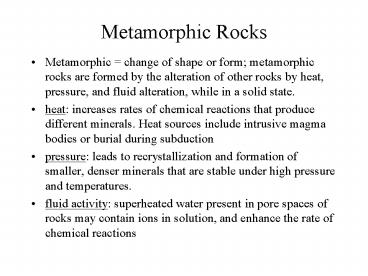Metamorphic Rocks - PowerPoint PPT Presentation
1 / 5
Title:
Metamorphic Rocks
Description:
Metamorphic Rocks ... heat: increases rates of chemical reactions ... Phyllite: similar to slate, but coarser grained, generally has a glossy or lustrous sheen ... – PowerPoint PPT presentation
Number of Views:1165
Avg rating:3.0/5.0
Title: Metamorphic Rocks
1
Metamorphic Rocks
- Metamorphic change of shape or form
metamorphic rocks are formed by the alteration of
other rocks by heat, pressure, and fluid
alteration, while in a solid state. - heat increases rates of chemical reactions that
produce different minerals. Heat sources include
intrusive magma bodies or burial during
subduction - pressure leads to recrystallization and
formation of smaller, denser minerals that are
stable under high pressure and temperatures. - fluid activity superheated water present in pore
spaces of rocks may contain ions in solution, and
enhance the rate of chemical reactions
2
3 types of metamorphism
- 1) Contact metamorphism takes place where magma
contacts country rock, includes heat and fluid
activity effects contact aureoles form in
concentric bands around contact zone - 2) Dynamic metamorphism Associated with fault
zones, where high differential pressure occur.
Results in mylonites, thin bands of hard, dense,
fine-grained rocks. - 3) Regional metamorphism Occurs over a large
area, usually caused by tremendous pressures,
temperatures, and deformation deep within the
crust, example convergent plate margins.
3
Index minerals
- Minerals that form only at specific temperature
and pressure ranges are known as index minerals.
These minerals allow geologists to identify low,
intermediate, and high grade metamorphic zones
(metamorphic facies). - The types of index minerals formed reflect the
original rocks, example at different
temperatures and pressures clay-rich shales may
form kyanite, sillimanite, or andalusite, all
with the same chemical formula (AL2SiO5), but
each with a different molecular geometry and
crystal habit.
4
Classification of metamorphic rocks
- Metamorphic rocks are divided into two groups
foliated or non-foliated. - Foliated rocks have mineral grains arranged in a
parallel or layered fashion. Foliated leaf
like, as in foliage. Foliated rocks include - Slate fine-grained, fissile or slaty cleavage,
formed from shale., color generally uniform - Phyllite similar to slate, but coarser grained,
generally has a glossy or lustrous sheen - Schist Contains platy or elongate minerals, with
clearly visible grains - Gneiss Characterized by streaks or bands of
light and dark minerals.
5
Non-foliated metamorphic rocks
- These have no platy minerals and exhibit a
granular texture. Include - Marble metamorphosed limestone or dolostone. May
range in grain size from fine- to
coarsely-granular. Quartzite recrystallized
sandstone, sugary in appearance. - Hornfels non-foliated, fine-grained rock formed
from non-fissile mudrocks - Greenstone includes any dark, mafic,
green-to-black rock containing chlorite, epidote
or hornblende.

